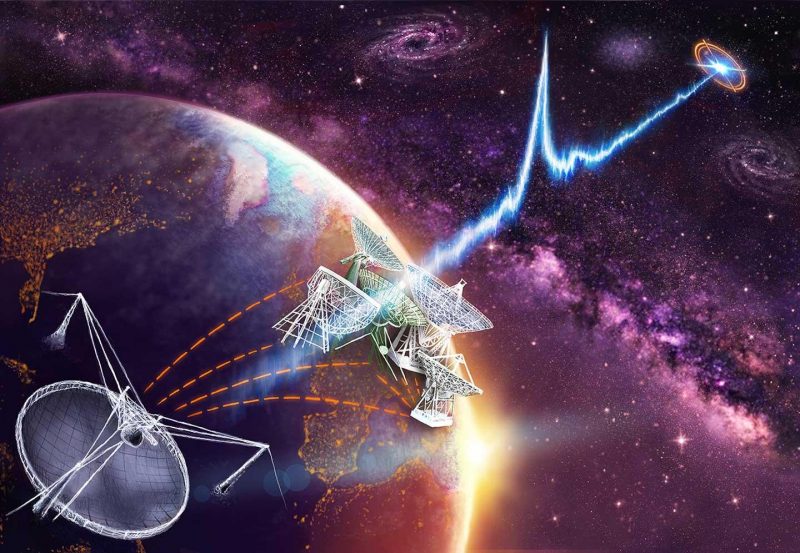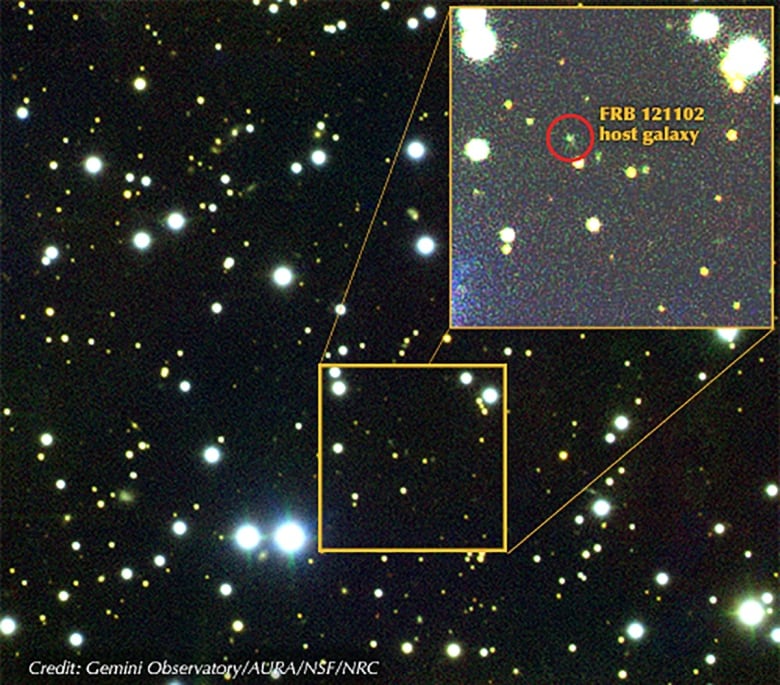

Artist’s concept of a Fast Radio Burst from a distant galaxy. Image via Danielle Futselaar.
Fast Radio Bursts (FRBs) are one of the most puzzling astrophysical discoveries in recent years. They are powerful but brief pulses of radio waves that seem to originate from galaxies billions of light-years away. Scientists don’t yet know what causes them, but they are finding more clues as they continue to investigate them. One oddity has been that of the more than 60 FRBs found so far, only one has ever been seen to repeat from the same source – until now.
Scientists in Canada detected a second repeating FRB using the Canadian Hydrogen Intensity Mapping Experiment (CHIME) radio telescope in the Okanagan Valley, British Columbia. It was reported by McGill University on January 9, 2019. The new findings were also published in two peer-reviewed papers in Nature on January 9 and presented at the American Astronomical Society meeting in Seattle on the same day.
Moon lovers! Order this year’s EarthSky lunar calendar here
The repeating FRB is one of 13 observed by CHIME over a period of three weeks during the summer of 2018. Additional FRBs were then found in the weeks following.
The detection of another repeating FRB is exciting since they seem to be relatively rare among FRBs in general. The first one was observed by the Arecibo radio telescope in Puerto Rico in 2015. According to Ingrid Stairs, a member of the CHIME team and an astrophysicist at the University of British Columbia (UBC):
Until now, there was only one known repeating FRB. Knowing that there is another suggests that there could be more out there. And with more repeaters and more sources available for study, we may be able to understand these cosmic puzzles – where they’re from and what causes them.

Canada’s CHIME radio telescope in the Okanagan Valley, British Columbia. Image via CHIME.
The detections by CHIME were a bit surprising – most FRBs found before were at a frequency close to 1400 megahertz (MHz), while the telescope’s observations were in the range of 400-800 MHz. But most of the first 13 new bursts were indeed lower in frequency, right down to the lowest frequencies that CHIME was able to detect. The scientists think that additional FRBs might be found that are even lower than the 400 MHz minimum.
So what do the new results mean?
Whatever the cause of FRBs is, it is something not seen before. Theories have ranged from exotic phenomena involving neutron stars or black holes to even – yes – aliens. As noted by Arun Naidu of McGill University:
Whatever the source of these radio waves is, it’s interesting to see how wide a range of frequencies it can produce. There are some models where intrinsically the source can’t produce anything below a certain frequency.
The first FRB – dubbed FRB 121102 – was discovered in 2007 by Duncan Lorimer and his student David Narkevic when they were looking through archival pulsar survey data.
As Tom Landecker, a CHIME team member from the National Research Council of Canada, added:
[We now know] the sources can produce low-frequency radio waves and those low-frequency waves can escape their environment, and are not too scattered to be detected by the time they reach the Earth. That tells us something about the environments and the sources. We haven’t solved the problem, but it’s several more pieces in the puzzle.
According to Kendrick Smith, a cosmologist at the Perimeter Institute for Theoretical Physics in Waterloo, Ontario:
FRBs were an unexpected mystery. There aren’t so many qualitative mysteries in astrophysics. So explaining their nature has become one of the biggest unsolved problems in astrophysics in the last few years.
CHIME is a unique radio telescope, designed and built by Canadian astronomers, explained Smith:
CHIME reconstructs the image of the overhead sky by processing the radio signals recorded by thousands of antennas with a large signal processing system. CHIME’s signal processing system is the largest of any telescope on Earth, allowing it to search huge regions of the sky simultaneously.

The first FRB – dubbed FRB 121102 – was discovered in 2007. This visible-light image shows its host galaxy. Image via Gemini Observatory/AURA/NSF/NRC.
Most astronomers are reasonably confident that a natural explanation will be found since FRBs have characteristics that make an intelligent source difficult. One problem, as explained by Seth Shostak, a senior astronomer at the SETI Institute, is that they appear to come from all over the sky, from galaxies separated by billions of light-years.
But you can safely bet that aliens are not the cause of FRBs. Why? The bursters are seen all over the sky, that’s why. The same sort of signal is coming from galaxies that are generally separated by billions of light-years. So how could aliens organize so much of the universe to engage in broadcasting the same sort of signal? There’s hardly been enough time since the Big Bang to coordinate such widespread teamwork, even if you can think of a reason for it!
It would be hard to fathom how aliens could coordinate such powerful radio blasts over such immense distances, but who knows? Occam’s razor would suggest that FRBs are most likely natural in origin – but determining just what is causing them will require continued observations.
Bottom line: FRBs are an exotic phenomenon, regardless of what specifically causes them, and thanks to new observations from telescopes like CHIME, scientists are another step closer to solving this fascinating mystery.
Source: Observations of fast radio bursts at frequencies down to 400 megahertz
Source: The source of a second repeating fast radio burst
from EarthSky http://bit.ly/2CvA6xB


Artist’s concept of a Fast Radio Burst from a distant galaxy. Image via Danielle Futselaar.
Fast Radio Bursts (FRBs) are one of the most puzzling astrophysical discoveries in recent years. They are powerful but brief pulses of radio waves that seem to originate from galaxies billions of light-years away. Scientists don’t yet know what causes them, but they are finding more clues as they continue to investigate them. One oddity has been that of the more than 60 FRBs found so far, only one has ever been seen to repeat from the same source – until now.
Scientists in Canada detected a second repeating FRB using the Canadian Hydrogen Intensity Mapping Experiment (CHIME) radio telescope in the Okanagan Valley, British Columbia. It was reported by McGill University on January 9, 2019. The new findings were also published in two peer-reviewed papers in Nature on January 9 and presented at the American Astronomical Society meeting in Seattle on the same day.
Moon lovers! Order this year’s EarthSky lunar calendar here
The repeating FRB is one of 13 observed by CHIME over a period of three weeks during the summer of 2018. Additional FRBs were then found in the weeks following.
The detection of another repeating FRB is exciting since they seem to be relatively rare among FRBs in general. The first one was observed by the Arecibo radio telescope in Puerto Rico in 2015. According to Ingrid Stairs, a member of the CHIME team and an astrophysicist at the University of British Columbia (UBC):
Until now, there was only one known repeating FRB. Knowing that there is another suggests that there could be more out there. And with more repeaters and more sources available for study, we may be able to understand these cosmic puzzles – where they’re from and what causes them.

Canada’s CHIME radio telescope in the Okanagan Valley, British Columbia. Image via CHIME.
The detections by CHIME were a bit surprising – most FRBs found before were at a frequency close to 1400 megahertz (MHz), while the telescope’s observations were in the range of 400-800 MHz. But most of the first 13 new bursts were indeed lower in frequency, right down to the lowest frequencies that CHIME was able to detect. The scientists think that additional FRBs might be found that are even lower than the 400 MHz minimum.
So what do the new results mean?
Whatever the cause of FRBs is, it is something not seen before. Theories have ranged from exotic phenomena involving neutron stars or black holes to even – yes – aliens. As noted by Arun Naidu of McGill University:
Whatever the source of these radio waves is, it’s interesting to see how wide a range of frequencies it can produce. There are some models where intrinsically the source can’t produce anything below a certain frequency.
The first FRB – dubbed FRB 121102 – was discovered in 2007 by Duncan Lorimer and his student David Narkevic when they were looking through archival pulsar survey data.
As Tom Landecker, a CHIME team member from the National Research Council of Canada, added:
[We now know] the sources can produce low-frequency radio waves and those low-frequency waves can escape their environment, and are not too scattered to be detected by the time they reach the Earth. That tells us something about the environments and the sources. We haven’t solved the problem, but it’s several more pieces in the puzzle.
According to Kendrick Smith, a cosmologist at the Perimeter Institute for Theoretical Physics in Waterloo, Ontario:
FRBs were an unexpected mystery. There aren’t so many qualitative mysteries in astrophysics. So explaining their nature has become one of the biggest unsolved problems in astrophysics in the last few years.
CHIME is a unique radio telescope, designed and built by Canadian astronomers, explained Smith:
CHIME reconstructs the image of the overhead sky by processing the radio signals recorded by thousands of antennas with a large signal processing system. CHIME’s signal processing system is the largest of any telescope on Earth, allowing it to search huge regions of the sky simultaneously.

The first FRB – dubbed FRB 121102 – was discovered in 2007. This visible-light image shows its host galaxy. Image via Gemini Observatory/AURA/NSF/NRC.
Most astronomers are reasonably confident that a natural explanation will be found since FRBs have characteristics that make an intelligent source difficult. One problem, as explained by Seth Shostak, a senior astronomer at the SETI Institute, is that they appear to come from all over the sky, from galaxies separated by billions of light-years.
But you can safely bet that aliens are not the cause of FRBs. Why? The bursters are seen all over the sky, that’s why. The same sort of signal is coming from galaxies that are generally separated by billions of light-years. So how could aliens organize so much of the universe to engage in broadcasting the same sort of signal? There’s hardly been enough time since the Big Bang to coordinate such widespread teamwork, even if you can think of a reason for it!
It would be hard to fathom how aliens could coordinate such powerful radio blasts over such immense distances, but who knows? Occam’s razor would suggest that FRBs are most likely natural in origin – but determining just what is causing them will require continued observations.
Bottom line: FRBs are an exotic phenomenon, regardless of what specifically causes them, and thanks to new observations from telescopes like CHIME, scientists are another step closer to solving this fascinating mystery.
Source: Observations of fast radio bursts at frequencies down to 400 megahertz
Source: The source of a second repeating fast radio burst
from EarthSky http://bit.ly/2CvA6xB

Aucun commentaire:
Enregistrer un commentaire